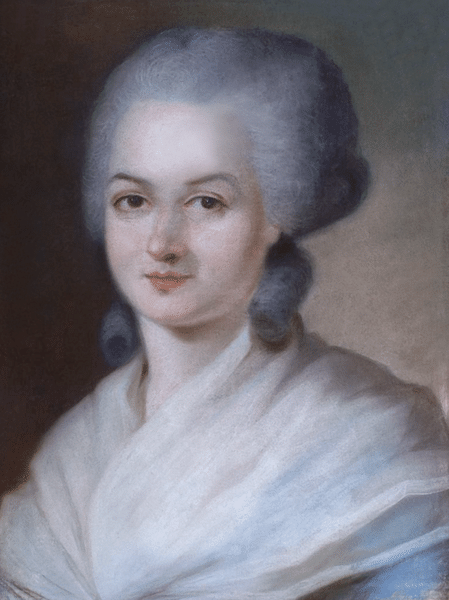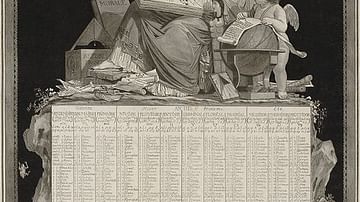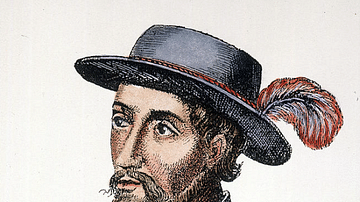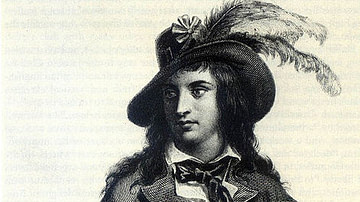The French Revolution (1789-1799) sought to dismantle the oppressive society of the old regime and build a new world based on the principles of "Liberty, Equality, Fraternity". This push for societal change led to a burgeoning feminist movement in Paris, as women leaders emerged to champion both revolutionary and feminist causes.

Prior to the Revolution, women were deemed to be 'passive' citizens, incapable of political agency, whose decisions had to be made for them by men. In France, as in other contemporary western societies, this was one of the justifications given for the subordination of women to men; prior to the Revolution, women barely had rights at all and were expected to do little more than be good wives and mothers. As with many aspects of society, these traditional gender roles were challenged during the French Revolution.
Women demonstrated their own political agency by instigating and leading some of the key moments in the Revolution; for instance, the Women's March on Versailles and the assassination of Marat by Charlotte Corday were both moments that exemplified the agencies of women who considered themselves patriots. They made their voices heard through pamphlets and newspapers and even took to the streets, creating their own women-only political clubs and militias. This revolutionary feminist movement was hindered by the Jacobins in 1793 and was reversed by the Napoleonic Code in 1804, which confirmed the status of women as secondary citizens.
The four women discussed in this article each became influential in revolutionary politics. Some advanced women's rights intentionally, while others did it as a byproduct of their zealous participation in the broader Revolution. The first two, Germaine de Staël and Olympe de Gouges, were women of letters who expressed their ideals with pen and paper, hosting political discussions with Paris' elites and intellectuals in their salons. The last two, Pauline Léon and Théroigne de Méricourt, were organizers, both of them forming their own political clubs and partaking in some of the most important actions of the Revolution. These are just four women whose leadership affected the French Revolution and advanced the feminist cause at one of the most important and volatile moments in the history of human rights.
Germaine de Staël
Anne Louise Germaine de Staël-Holstein (22 April 1766 to 14 July 1817), better known as Madame de Staël, was a Swiss-French writer, political theorist, and salonnière who rose to political prominence during the Revolution. Born Germaine Necker, she was the daughter of the wildly popular royal finance minister Jacques Necker and the salonnière Susanne Curchod. Germaine was educated in her mother's salon, where she was first exposed to the works of Enlightenment Age philosophers Jean-Jacques Rousseau and Baron Montesquieu. In 1786, Germaine married a Swedish diplomat, Baron Erik Magnus Staël von Holstein, and completed her first three-act play the same year. In 1788, de Staël rose to prominence when she published a highly regarded book on Rousseau, titled Letters on the Works and Character of J.J. Rousseau. At the time of the book's publication, she was only 22.
With the outbreak of the Revolution in 1789, de Staël became politically involved; although she could not legally hold political office, she frequently attended meetings of the National Assembly and became acquainted with many of the elected deputies. She opened her own salon at the Swedish embassy in Paris, where she hosted a slew of French nobles, foreign dignitaries, and influential political figures. The dinners she held at her salon and at her townhouse were frequented by the likes of Marquis de Lafayette, Thomas Paine, Thomas Jefferson, and Sophie de Condorcet; these fashionable dinners helped shape public revolutionary discourse in Paris. De Staël delighted in hosting people from across the political spectrum and winning them over to her side through her personal charisma and refined debating skills.
During the early phase of the Revolution, de Staël was considered a radical, favoring the implementation of a parliamentary monarchy based on the model of Great Britain, but as the Revolution continued in an increasingly radical direction, de Staël found her positions aligned more with the moderate Girondin faction. In the summer of 1793, the extremist Jacobins came to power and purged the Girondins from the government. Although initially protected from arrest by her husband's diplomatic status, the escalation of the Reign of Terror forced de Staël to flee to Coppet, Switzerland. Here, she continued writing on French politics, at one point writing in defense of the character of the recently executed Queen Marie Antoinette, arguing in part that her vilification had been tied to her womanhood. De Staël returned to France in 1795 after the Jacobins had been removed from power, but she was forced into exile again in 1804, having become an outspoken opponent of Napoleon Bonaparte. De Staël then traveled throughout Germany, becoming involved in the European Romanticism movement and befriending Lord Byron, before returning to Paris after the Bourbon Restoration in 1815.
Olympe de Gouges
Another prominent French woman of letters was Olympe de Gouges (7 May 1748 to 3 November 1793), a playwright and activist. Born in Montauban in southwestern France, de Gouges moved to Paris in 1768 and published her first novel in 1784. She used her newfound recognition as a writer to defend the causes of marginalized groups; one of her first popular plays, L'Esclavage des noirs ("The Slavery of Blacks") championed the abolitionist movement. The play was shut down after only three performances, however, since the slave trade littered newspapers with poor reviews and paid hecklers to disrupt the shows. In 1788, de Gouges wrote an essay entitled Reflections on Black Men, in which she tied the horrors of colonialism and slavery to autocratic governments and monarchies. Her abolitionist beliefs earned her threats and public attacks, not only from pro-slavery lobbyists but also from those who believed women did not belong in the theatre. De Gouges remained defiant, writing that she was determined to be a success in spite of her enemies.
In 1789, the French revolutionaries formed the National Constituent Assembly, which set about its task of writing a new, enlightened constitution for France. As a preamble to this forthcoming constitution, the Assembly adopted the Declaration of the Rights of Man and of the Citizen, one of the most significant human rights documents of its day. Yet feminists like de Gouges could not help but notice that the declaration denied women the right to citizenship and remained vague on the topic of other women's rights. In defiance, de Gouges began signing her letters as "citoyenne" (the female form of citizen).
In 1791, she penned an official response to the declaration entitled "Declaration of the Rights of Woman and of the Female Citizen". Her version echoed the original declaration point for point, differing in its inclusion of women in the rights that had been given only to men. De Gouges caused controversy by dedicating her text to Marie Antoinette, who she described as "the most detested of all women", and by declaring that the Revolution could only reach its full potential when women became aware of their "deplorable condition". "Women wake up," de Gouges writes in the postscript, "the tocsin of reason is resounding throughout the universe: acknowledge your rights." De Gouges' writing made waves with its sarcastic and militant tone, and earned her powerful enemies; the Jacobins detested the mocking spirit of de Gouges' work and viewed the dedication to the queen as anti-republican. De Gouges, like de Staël, was aligned with the Girondins and had initially supported a constitutional monarchy; after the fall of the Girondins in the summer of 1793, she called for a plebiscite to be held so the people could choose their own form of government. The Jacobins viewed this as de Gouges advocating for a restoration of the monarchy. She was arrested, subjected to a show trial, and guillotined on 3 November 1793.
Pauline Léon
Germaine de Staël and Olympe de Gouges were representative of the early phase of the Revolution, which had been guided by moderate liberalism and led by bourgeois intellectuals. But as the Revolution progressed, it became increasingly extremist and militant, as more power fell into the hands of working-class revolutionaries known as sans-culottes (literally, "without silk breeches"). Groups of militant feminists, or fille sans-culottes, also appeared during this time, with one of the most notable being Pauline Léon (28 September 1768 to 5 October 1838). Léon had become radicalized from an early age; her father had died when she was still a child, forcing her to step up to raise her five younger siblings and help her mother run the family's chocolate-making business. The experience taught Léon the value of independence, and it also opened her eyes to the disparities in French society, particularly in the inequalities present in gender roles.

Léon welcomed the Revolution and wasted no time picking up a pike. She participated in the Storming of the Bastille on 14 July 1789 and was present at the anti-royalist demonstration that was fired upon by National Guards at the Champ de Mars Massacre two years later. Léon detested moderates, exhibiting a particular hatred for Lafayette, and was often present at meetings of the radical Cordeliers Club. Unlike de Gouges, Léon was not a feminist for the sake of women's rights alone and did not necessarily fight for gender equality. However, she was an ardent believer in the Revolution and believed that women should be able to defend the patrie (fatherland) just as men were able to. She was an outspoken proponent of giving women the right to bear arms, and she even spoke before the National Assembly to ask for the formation of an armed women's militia. This never came to fruition but would have been incredibly radical, as the right to bear arms was closely associated with citizenship.
Léon's extremist views aligned with the Jacobins, but since the Jacobin Club only admitted male members, she found it necessary to form her own political club. Alongside her close friend Claire Lacombe, Léon co-founded the Society of Revolutionary and Republican Women. The Society advocated for gender equality in revolutionary politics and was active on the extreme political left; it aided in the insurrection that led to the fall of the Girondins on 2 June 1793 and raised an obelisk to commemorate the memory of radical leader Jean-Paul Marat, after his assassination on 13 July. The Society controversially petitioned the National Convention to make it compulsory for all women to wear the tricolor cockade, which had masculine associations. The Convention passed such a decree in September, though many women still refused to wear the cockade.
After the death of Marat, the Society began to veer left of the Jacobins, and aligned themselves with an anti-Robespierrist group called the Enragés; Léon married Enragé leader Theophile Leclerc. Since the Enragés were seen as rivals by the Jacobins, this put the Society at odds with the Jacobin-dominated National Convention; many Jacobins also subscribed to the idea that women should not participate in politics. For these reasons, women were officially forbidden from forming any political clubs or organizations, regardless of ideology, on 30 October 1793. The Society of Revolutionary and Republican Women was disbanded, and Léon herself was briefly arrested, though she was released after the fall of Maximilien Robespierre in 1794. After her release, Léon withdrew from politics to become a schoolteacher, continuing in the profession until her death in 1838 at the age of 70.
Théroigne de Méricourt
One of the more mysterious women organizers of the Revolution was Théroigne de Méricourt (13 August 1762 to 8 June 1817), whose true story must be discerned from the many lies and rumors told about her which still persist today. She was born in the town of Marcourt in modern Belgium to a peasant family. Théroigne's stormy relationships with her father and stepmother caused her to leave her hometown before the age of 16, after which she traveled Europe as a singer and a courtesan. She lived a storied life even before her revolutionary involvement and wound up in Paris in 1789 on the eve of the Revolution.
Théroigne immediately took a special interest in the unfolding events, as her travels and experiences had made her sympathetic to the downtrodden. She was fascinated by the meetings of the National Assembly and decided to move to the Rue de Noailles in Versailles to ensure she did not miss a single Assembly meeting. Since the involvement of women in political affairs was generally frowned upon, Théroigne would often attend these meetings dressed in a man's riding habit and a large, round hat. This would become her signature outfit. Théroigne was a charming, attractive, and outspoken woman who did not take long to befriend some of the Assembly deputies and involve herself in politics. She co-founded the short-lived Society of the Friends of the Law in January 1790, which sought greater involvement of the provinces in revolutionary activity. She spoke both at the podium of the National Assembly and at the Cordeliers Club, where she advocated for radical ideals and quickly gained a following among the sans-culottes of Paris.
Théroigne's newfound notoriety and propensity to dress like a man made her an easy target for royalist newspapers. She was mockingly referred to as the "patriots' whore" and was accused of leading both the Storming of the Bastille and the Women's March on Versailles; while she did participate in the march on Versailles, she did not lead it, and there is no evidence that she was present at the Bastille. The tabloids accused her of fighting soldiers and of prostituting herself to the National Assembly so that "every representative may fairly claim to be the father of her child" (Hamel, 119).
This constant slander greatly affected Théroigne, who returned to her hometown in May 1790 to get away from Paris politics. From there she traveled to Liège, where she was arrested by Austrian authorities who were aware of her exaggerated revolutionary involvement from the French royalist press. Accused of being a spy sent to foment insurrection in Belgium, Théroigne was kept prisoner for months and was greatly mistreated by the guards. She was released once it was determined there was no evidence against her, but she had developed significant health issues while in prison, including depression, migraines, and coughing of blood.
When Théroigne returned to Paris in January 1792, she was hailed as a hero for her ordeal at the hands of the Austrians and was proclaimed by the revolutionaries as an "Amazon of liberty". She gave a speech at the Jacobin Club, adorned in her now famous scarlet riding habit and plumed hat, with a pistol in her belt and a saber at her side. Théroigne resumed her role as a public speaker and activist, campaigning for women's rights to bear arms and even attempting to recruit a women's militia. She may have helped coordinate the riots of 10 August 1792, which resulted in the Storming of the Tuileries Palace and the end of France's monarchy. This was the peak of her popularity.
Although she continued attending meetings of the Jacobin Club, Théroigne's own politics soon began to align more with the Girondins. As tensions between the Jacobins and Girondins heated up in early 1793, Théroigne's moderatism made her a target to radical Jacobins. On 15 May 1793, Théroigne was giving a pro-Girondin speech in the Jardin des Tuileries when she was attacked by a group of women sympathetic to the Jacobins. She was stripped naked and severely beaten; she was probably saved from death only by the intervention of Jacobin leader Jean-Paul Marat. Tragically, Théroigne suffered severe head trauma during her beating and never totally recovered. Her behavior became increasingly erratic, to the point where she was declared certifiably insane on 20 September 1794. She was sent first to an asylum in Faubourg Marceau before being transferred to La Salpêtrière woman's hospital in 1807, where she would remain for the rest of her life, dying after a short illness in 1817.
Conclusion
Germaine de Staël, Olympe de Gouges, Pauline Léon, and Théroigne de Méricourt each came from immensely different backgrounds and differed greatly in their worldviews; while de Gouges fought primarily for the rights of women and slaves, Léon engaged in feminism as a means to an end, which was the success of the French Republic. Yet by the mere virtue of being politically significant women, they each challenged traditional gender roles by entering the political sphere.











